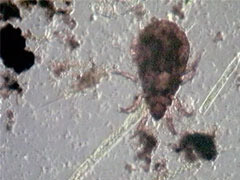Oribatida (Arachnids)
The water mites, a grouping of nine superfamilies and more than 40 families of Hydracarina worldwide, comprise more than 5,000 named species in the suborder Oribatida that are truly aquatic. Occupying all types of freshwater habitat from tree hollows to hot springs, deep lakes, and torrential waterfalls, a few species have also invaded marine ecosystems.

Oribatida Video #1
A water mite is a bystander as a larger creature captures prey; under oblique illumination with a playing time of 14 seconds. Choose a playback format that matches your connection speed:
Oribatida Video #2
A water mite slowly picks his way through debris in pond water; under oblique illumination with a playing time of 36 seconds. Choose a playback format that matches your connection speed:
Rather than taxonomic characteristics or evolutionary relationships, what distinguishes the Hydracarina from the other arachnids in the mite and tick order Acarina is that the nymph and adult life stages are completed underwater. However, being solely aquatic, some species of water mite feature adaptations to the reproductive organs to ensure successful egg fertilization, as well as modifications to the legs that make them better adapted to swimming.
The life history patterns of water mites are diverse and complex. Some species lay their eggs underwater, attached to submerged stones or aquatic plants, while others extrude their eggs into living plant tissue or into the tissues of freshwater sponges and unionid clams. In species that are most adapted to aquatic living, the water mite larvae parasitize larval dragonflies or pupal dipterans such as mosquitoes. After feeding on their host aquatic invertebrates, the mite nymphs develop into free-swimming, robust, round and brilliantly colored orange, red, or yellow juvenile mites. The bright colors serve as warning coloration to potential predators since the water mites are usually very distasteful. Noxious secretions from skin glands help protect these invertebrates from being eaten. The adults of most species (as illustrated here) more closely resemble their terrestrial relatives, and are usually predators of aquatic insects, crustaceans, and other mites, as distinct from the parasitism that they display in the larval stages.
